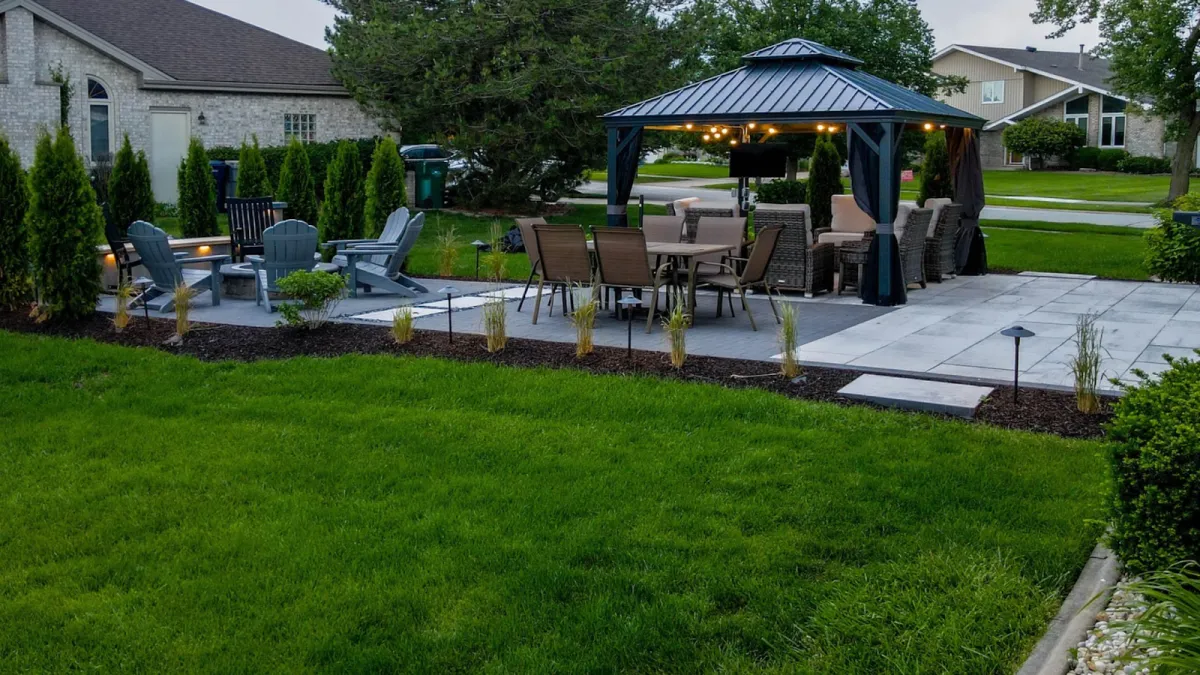Blogs

What Are The 5 Elements Of Landscape Design?
The five key elements of landscape design are color, form, line, scale, and texture. Color brings vibrancy and helps set the mood of the area. Form refers to the shapes and structures of plants and objects. Line guides the viewer's eye and creates visual flow. Scale ensures that elements are proportionate and harmonious, while texture adds depth and interest through the surface qualities of various materials and plants.
Landscape design is a complex blend of art and science that transforms outdoor spaces into beautiful, functional environments. At its core, landscape design revolves around five essential elements: color, line, texture, form, and scale. These elements, when skillfully combined, create a harmonious and visually engaging outdoor space. Whether you are updating a patio or embarking on a complete outdoor renovation, understanding these elements can help you achieve your dream landscape. Landscaping Experts Inc., Joliet’s premier outdoor living company, is here to guide you through the essentials of landscape design.
Key Takeaways:
Color: Influences mood and visual perception, creating focal points and guiding the eye.
Line: Defines spaces and guides movement, with straight lines for formality and curves for relaxation.
Texture: Adds depth and interest through varied visual and tactile qualities.
Form: Shapes and structures that contribute to the overall design, balancing geometric and organic elements.
Scale: Ensures proportional harmony between landscape elements and the overall space.
The Five Elements of Landscape Design
Color
Color is a powerful tool in landscape design that can influence mood and perception. Warm colors like reds, oranges, and yellows can make spaces feel more intimate and lively, while cool colors such as blues, greens, and purples provide a calming effect and can make small areas appear larger. The strategic use of color in plants, flowers, and hardscapes helps create focal points and guides the viewer’s eye through the landscape.
Line
Lines are fundamental in guiding the eye and defining spaces within the landscape. Straight lines are typically used to create a formal, structured look, ideal for contemporary gardens or pathways. In contrast, curved lines are more relaxed and natural, promoting a sense of movement and tranquility. The use of lines can direct traffic flow, highlight focal points, and create a sense of order in the garden.
Texture
Texture in landscape design refers to both the visual and tactile qualities of surfaces. This includes the roughness of tree bark, the smoothness of leaves, and the varied textures of hardscaping materials like stone and wood. By combining different textures, you can add depth and interest to your landscape. Fine textures, such as delicate foliage, can make spaces feel larger, while coarse textures, like large-leaf plants, can make areas feel more intimate.
Form
Form pertains to the shapes and structures of landscape elements. This can range from the geometric shapes of formal gardens to the more organic forms found in naturalistic designs. Trees, shrubs, and hardscaping features like pergolas or fountains all contribute to the overall form of the landscape. A well-balanced design often incorporates a mix of forms to create visual interest and cohesion.
Scale
Scale is about the proportional relationship between different elements in the landscape and the overall space. Proper scaling ensures that all components, from plants to furniture, work together harmoniously. Large elements in small spaces can feel overwhelming, while too many small elements in a large area can feel cluttered and disjointed. Maintaining a balanced scale is crucial for a harmonious design.
Key Elements of Landscape Design: Color, Lines, Texture, Form, and Scale
1. The Importance of Seasonal Color in Landscape Design
Seasonal color plays a vital role in maintaining the vibrancy and appeal of a landscape throughout the year. By selecting plants that bloom in different seasons, you can ensure that your garden remains colorful and engaging regardless of the time of year. Incorporating a mix of annuals, perennials, and evergreens can provide a continuous display of color, adding dynamic visual interest and enhancing the overall aesthetic appeal of your outdoor space.
2. How to Use Lines to Create Focal Points in Your Garden
Creating focal points in a garden helps draw attention to specific areas and adds structure to the design. Lines, both straight and curved, can be strategically used to lead the eye towards these focal points, such as a beautiful tree, a water feature, or a sculpture. Straight lines create a sense of order and formality, ideal for classical gardens, while curved lines offer a more relaxed and natural feel, perfect for informal and modern garden designs.
3. Enhancing Landscape Texture with Hardscaping
Hardscaping elements like stone pathways, wooden decks, and metal sculptures can significantly enhance the texture of a landscape. These materials provide contrast against the soft textures of plants and flowers, adding visual interest and complexity. Integrating hardscaping with natural elements creates a balanced and aesthetically pleasing environment, offering both functional benefits and decorative appeal.
4. Balancing Form and Function in Landscape Design
Achieving a balance between form and function is essential in landscape design. While the visual appeal of shapes and structures is important, ensuring that these elements are functional is equally critical. For instance, a beautifully designed seating area should also be comfortable and accessible. Balancing these aspects ensures a landscape that is not only attractive but also practical and enjoyable to use.
5. The Role of Scale in Creating a Cohesive Landscape
Scale is crucial in creating a cohesive landscape design. Ensuring that plants, structures, and decorative elements are proportionate to each other and to the overall space is key to achieving harmony. Proper scaling prevents elements from feeling out of place and helps create a unified and balanced look. Attention to scale ensures that the landscape feels natural and well-integrated.
FAQs
What is the most important element in landscape design? Each element of landscape design is crucial, but balance and harmony often emerge as the most important aspects. Properly combining color, line, texture, form, and scale ensures a cohesive and appealing design.
How can I add more color to my landscape design? Incorporate a variety of plants that bloom in different seasons, use colorful hardscaping materials, and consider adding features like outdoor art or furniture in vibrant hues to enhance the color palette.
What are some common mistakes in landscape design? Common mistakes include neglecting scale, overusing a single element, failing to consider maintenance needs, and not accounting for the growth of plants over time. Proper planning and balance are key to avoiding these pitfalls.
How do I choose the right plants for my landscape? Consider factors such as climate, soil type, sunlight, and water requirements. Additionally, think about the desired color scheme, texture, and form to ensure the plants complement the overall design.
Can I incorporate all five elements into a small garden? Yes, even small gardens can benefit from incorporating all five elements. Careful planning and thoughtful selection of plants and materials can create a balanced and visually appealing small space.
Achieving Harmony in Your Landscape with Landscaping Experts Inc.
Creating a stunning landscape involves more than just planting a few flowers or installing a patio. It requires a deep understanding of the five essential elements of landscape design: color, line, texture, form, and scale. By thoughtfully integrating these elements, you can transform your outdoor space into a harmonious and functional retreat.
Landscaping Experts Inc. is here to help you every step of the way. With over 30 years of experience, we are Joliet's #1 premium outdoor living company. Our team of experts is committed to delivering the highest quality of service, ensuring your outdoor space reflects your unique style and needs. Contact us today to schedule a free consultation and take the first step towards creating the outdoor living space you’ve always wanted.

Follow Us
Service Areas
Plainfield
Shorewood
Morris
Lake Forest
Winnetka
Hinsdale
Western Springs
Hinsdale
Service Areas
Wilmette
Northbrook
Montgomery
Deerfield
Saint Charles
Kelinworth
Golf
Campton Hills
Barrington
Hoffman Estates
Copyright © Landscaping Experts Inc. 2025. All Rights Reserved. Privacy Policy. Terms & Conditions. Web Design by Fused Media

